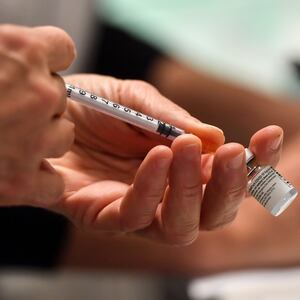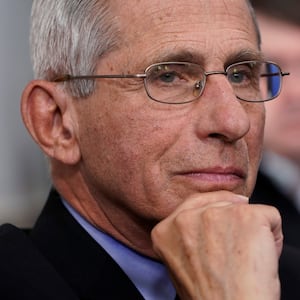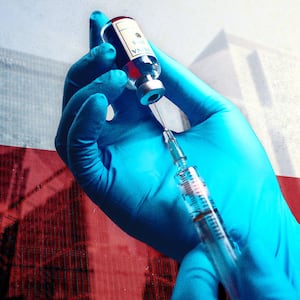Senior officials working with the White House coronavirus task force and Operation Warp Speed are pushing for states to begin handing out some of their excess COVID-19 vaccine doses to whoever wants it, according to four individuals familiar with the matter.
The plan is already in motion, with federal officials already talking to states about it. If further enacted, the shift in distribution could upend months of debate and strategizing about who should get the vaccine first. But officials argue that this first-come, first-served approach may be one of the only ways to ensure that millions of vaccine doses don’t expire on the shelf. So far, 24 million doses have been allocated to states, with roughly 28 percent of those doses administered.
President Donald Trump at one point said there would be 100 million doses prepared by the end of 2020. More recently, officials said they would have 20 million doses administered by then. That didn’t happen. In mid-December states began to report a range of issues—deliveries of doses delayed, vaccination reporting systems shutting down. And as the New Year rolled by, the administration had still not reached its target.
ADVERTISEMENT
While administration officials, citing everything from production and quality control sluggishness to allocation scheduling conflicts, have admitted there was a slight lag in getting the first batches out to states, they have repeatedly told their local counterparts that distribution would soon get back on track. Internally, though, federal officials in recent days have begun to worry that there are issues at every step in the supply chain that could further slow the vaccination rate. A surprising number of healthcare and frontline workers haven’t shown up for their vaccinations or are refusing to get them. (According to a Los Angeles Times report, one hospital in northern California has vaccinated less than half of its staff.) Refrigerators have broken, spoiling dozens of doses. And states have struggled to find enough individuals to administer the vaccines.
“If we have a big surge in cases and deaths after the December holidays and we don’t have the vaccine distribution plan back on course we’re in big trouble,” one senior administration official said.
As part of the conversations about how to quickly improve distribution, officials in task force meetings, in interagency phone calls and in a Camp David summit Tuesday suggested that states should distribute the vaccine—doses that may soon expire—to any individuals who want to get inoculated. These people would get the vaccine, even if they are not frontline healthcare workers, essential workers, over the age of 75 years old. There has been no formal decision to draft recommendations in this vein, officials said they are not against states pursuing this course of action and have transmitted to some local officials that they should embrace the idea. Health and Human Services Secretary Alex Azar and other top Operation Warp Speed officials met at Camp David Tuesday to discuss the next two weeks of the vaccination rollout and the transition to the Biden administration.
“We need to make sure that the critically ill and most vulnerable people are getting this vaccine first,” one senior administration official said. “But after that if there are doses that are just sitting in fridges expiring, we got to get them out there.”
Senior administration officials working on the vaccine distribution process are adamant that allowing vaccine doses to be thrown out is not an option and that local officials should allow for their distribution to anyone who wants them. The question, officials said, is how states regulate that process and keep track of who has been vaccinated, when they need to receive their second doses, and whether the state has enough doses to ensure each recipient gets both doses.
There are signs that individual hospitals and pharmacies are already taking the first-come, first-served approach. On Monday news broke that Giant pharmacy in Washington, D.C. had given a vaccine shot to someone walking through the store because the healthcare workers who were scheduled to receive their shot did not show up. In Louisville, a couple received vaccine shots at Walgreens on Christmas Eve after they heard that there were extra available. And a California hospital gave away hundreds of doses to jail and nursing home staff after its freezer malfunctioned.
“The releasing of the vaccine if it isn’t going to be unused… if it’s been thawed… we should absolutely get rid of this stuff,” said Juliette Kayyem, a former assistant secretary in the Department of Homeland Security. “I think local ingenuity is really important. It should be welcomed. You want nimbleness at the local level with money coming with from the feds.”
It’s all part of a broader conversation within the administration’s health agencies and among White House task force members about why the vaccine rollout has been so bumpy. The vaccination effort was always going to be complicated—it’s the largest such campaign in American history, after all—there was some confusion on the state’s part from the beginning about exactly how much federal support they’d receive in the administering process once Operation Warp Speed shipped the vaccine.
For officials in the federal government working on Operation Warp Speed overseeing the distribution campaign, no one can seem to decide why the vaccination numbers nationwide are so low. Some officials said it’s because states aren’t doing their jobs at getting people to sign up and show for their vaccination appointments. Others say the public education about the vaccination process and its efficiency has been woefully inadequate.
What’s more, every state is experiencing the vaccination distribution differently. Some states are experiencing long lines of individuals showing up for their shots. Other states seem to be struggling to get the vaccines out of the freezer into people’s arms.
Officials inside the administration’s major health agencies, including the CDC and HHS, say one of the biggest problems is the lack of an accurate and reliable vaccination reporting system. One official said some states are asking individuals to sign on to state and municipal-run databases after their vaccination to report that they have received their shots and not everyone does so. Another official said there is no centralized reporting system that states can use to report their numbers to the CDC. Officials inside the CDC have wanted to work more intently on accumulating, aggregating, and analyzing the data but there has been pushback from the White House and other senior health officials, one senior official said.
One senior official told The Daily Beast that as part of the hours-long meeting Camp David meeting Tuesday, officials discussed the need for states to hand out the vaccine to individuals outside of the frontline health-care worker population if there are leftover doses. They also put together a plan to work with states over the next two weeks to ensure that vaccine shipments are sent to pharmacies instead of health-care departments or hospitals as a way to make the distribution process easier and more manageable. Operation Warp Speed officials hope to use the partnership with more than 19 pharmacy chains in 40,00 locations across the country to scale distribution by February.
The more pressing question, one senior administration official said, is how the Trump administration and the incoming Biden team tackle vaccine hesitancy. If individuals refuse to get the vaccine—especially frontline workers—it will take months longer to reach widespread immunity through vaccination. To that end, individual members of the Trump administration’s White House coronavirus task force have taken it upon themselves to speak with the media and appear virtually at private events to tout the vaccine’s efficacy.
HHS has also launched a campaign known as “Vaccinate with Confidence” to increase education on the issue. The goal of the campaign is to reinforce the safety of the vaccine—and the importance of slowing the spread—in part through promotional videos and advertisements. One December social media campaign titled “Prepare the Nation'” has reached users on Facebook, Instagram, Snapchat and Pinterest. As of last week the campaign had 74 million impressions and 7 million video views, according to an HHS presentation obtained by The Daily Beast.









